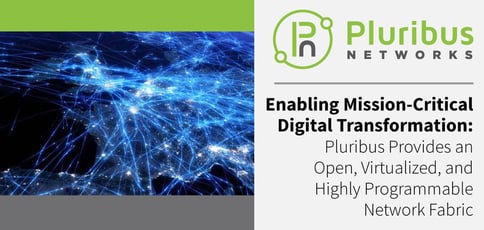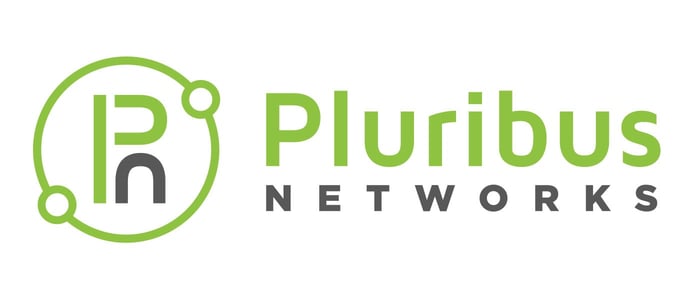
TL; DR: Pluribus provides fully automated datacenter network fabrics that dramatically simplify the operations of its customers. The company’s open, controller-less software-defined networking (SDN) infrastructure combines network virtualization, segmentation, visibility, and analytics into an easy-to-use solution for a variety of use cases. Now, with the Pluribus Adaptive Monitoring Fabric, the company is introducing the industry’s first integrated packet broker fabric that is simple to deploy, scales seamlessly across distributed datacenter networks, and can rapidly adapt to changing network conditions.
Digital transformation is no longer just a buzzword. According to Forbes, 27% of senior executives consider it a matter of survival.
In 2019 alone, companies were expected to spend more than $2 trillion on digital transformation efforts, most of which were spurred by new growth opportunities, increased competition, and changing regulatory standards.
To compete and thrive in the future, businesses must take full advantage of the opportunities provided by emerging technology — or be left in the dust. That’s why now, more than 200 customers and partners, including mobile operators, hosts, and managed services providers, are turning to Pluribus Networks to meet the rapidly evolving needs of the businesses they serve.
As a leader in open networking, software-defined networking (SDN), and network virtualization, Pluribus offers a revolutionary way to build datacenter network fabrics. The company takes customers beyond the legacy approach, which is fading into obscurity due to high costs, vendor lock-in, cumbersome box-by-box configuration, and slow feature velocity.

Pluribus delivers advanced datacenter network fabrics that simplify the operations of its customers.
While many modern approaches to building data center fabrics leverage a central SDN controller, Pluribus evolved the technique one step further.
“The first iteration of software-defined networking relied on controllers that are separated from switches, and it programmed those switches through an out-of-band (OOB) network,” said Jay Gill, Senior Director of Marketing at Pluribus. “Then those switches implemented whatever forwarding was required.”
The method worked well to demonstrate that embedding the control plane into software, rather than hardware, could lead to enhanced flexibility. But it left challenges in terms of single points of failure and limited geographic scale.
“The general idea of SDN, the disaggregation of software and hardware, worked well, but there was a better way to do it,” Jay said. “And that better way is what we call our Adaptive Cloud Fabric, which is a controller-less SDN fabric.”
Leveraging Next-Gen Software-Defined Networking
The Pluribus Adaptive CloudFabric, powered by the Netvisor ONE networking operating system, is 100% software-enabled but eliminates the SDN controller, simplifying the architecture and supporting distributed, multilocation environments.
It also is extremely scalable and optimized to deliver the continuous availability needed in many mission-critical enterprise and service provider environments. Pluribus Adaptive Cloud Fabric can be deployed in a single data center, deployed across an entire campus, or geographically distributed to seamlessly connect dozens of data centers.
Jay said the Adaptive Cloud Fabric’s controller-less, distributed architecture provides an automated plug-and-play solution via an SDN that adapts to change, improves efficiency, and streamlines operations.

Adaptive Cloud Fabric is a next-gen form of software-defined networking.
“We embedded the control of the network into a distributed control plane, so it rests on every switch in the network – and that means that every switch has a view of the entire network state,” Jay said. “It’s completely distributed and replicated, so you don’t have to have external controllers. There’s no single point of failure, and any switch in the network can be used as the entry point to make changes that propagate throughout the network.”
Underneath the SDN control layer are standard networking protocols, allowing for seamless interoperability with existing network infrastructure. “You can start building this fabric alongside your existing network and not have to rip out or replace the whole thing all at once,” Jay said.
Ultimately, empowering customers to enjoy a more streamlined migration into SDN architecture while maintaining existing investments helps lower total cost of ownership.
Serving More than 150 Enterprises and Service Providers Worldwide
Jay told us that Pluribus is a relatively small company with an extensive global reach. The company’s broad customer base, which includes household names like Comcast, Verizon, Samsung, State Farm, and Equinix, underscores its ability to deliver battled-tested solutions tailored to mission-critical networks.
Pluribus also boasts strategic partnerships with the likes of Ericsson, TIBCO, Edgecore Networks, and Dell Technologies.
“We’re based in Silicon Valley with global support and partnerships with some big industry players,” he said. “With Ericsson, we have an OEM supply agreement to deliver our software into their infrastructure solutions, so when they build mobile network infrastructure for the largest global operators in the world, Pluribus software comes along with that.”
The company’s partnership with Dell Technologies helps Pluribus reach a broader set of customers, including service providers, enterprises, and smaller commercial operations.
“Dell Technologies, of course, is a major player with a global presence, so we amplify what we do through them,” Jay said. “We’re one of their preferred suppliers of software for open networking.”
Pluribus also works with Edgecore Networks, which Jay describes as a pure-play open network hardware provider.
“The customers who are most committed to open networking and want to make their own choices about hardware and software are often attracted to buying Edgecore and then buying Pluribus separately, or, in some cases, purchasing a combined solution,” Jay said. “The partnership helps us reach the do-it-yourself, forward-leaning customer.”
Enabling Interconnectivity, Low-Latency, and Business Continuity
Jay said it’s becoming more common these days for enterprises and managed cloud service providers to leverage colocation and multitenant datacenter (MTDC) environments for private cloud infrastructure. This means that MTDCs are increasingly becoming a critical component of hybrid multicloud strategies.
To that end, Pluribus is making it easier for small colocation and MTDC providers to tap into the power of the Adaptive Cloud Fabric via its turnkey interconnect fabric. One of the company’s regional colocation providers, for example, used the multisite interconnect services to set up fabric between all five of its datacenter sites.
“Each datacenter that it operates has access to the cloud services or other service providers in any of the other datacenters, which creates value because there’s a large ecosystem of people to connect with,” Jay said. “This colo provider loves the fact that the multisite fabric concept provides visibility and manageability across the network.”

The company’s SDN interconnect fabric makes it possible to share assets across multiple datacenters.
Another customer, Econocom Italia, chose Pluribus Networks to support its hybrid Naboo Cloud Service because of the flexibility, simplicity, and efficiency of the Linux-based Netvisor ONE operating system. The OS features the Adaptive Cloud Fabric running on the Dell Technologies Open Networking switches.
“They have four datacenters, and they can put infrastructure in any one of those data centers and give people access to the services across them,” Jay said. “The key thing for them — and for many other multitenant service providers leveraging the interconnect use case — is network segmentation, where everybody’s slice of the network looks completely private. They don’t see the other tenants, and there are no security concerns.”
For Econocom, the solution meant easy and flexible customer onboarding. “The programmability, performance, and economics of our software-defined infrastructure are critical to our success and the foundation of our customer experience,” said Paolo Bombonati, Chief Operating Officer at Econocom Italia.
But the company’s experience helping customers navigate data center modernization doesn’t end there. Pluribus has helped many others, such as Scavolini, a growing retailer with international operations and manufacturing facilities, transform their datacenter infrastructure, leading to better network and application performance, in addition to new capabilities and features.
New Offerings: Adaptive Monitoring Fabric
One of the company’s newest offerings is the Pluribus Adaptive Monitoring Fabric.
Jay told us that network visibility monitoring is already built in the Pluribus platform on a powerful level. Still, customers looking for an even richer network monitoring approach often turn to technology known as network packet brokers.
With its Adaptive Monitoring Fabric, Pluribus takes advantage of its core technology and applies it to a network monitoring packet broker application.
“It can be a complete overlay monitoring network, which is the traditional way to do it,” Jay said. “Or, it can be a hybrid deployment integrated into the production network as a virtualized packet broker service running on the same switches that are providing network services. It’s pretty powerful in that way.”
HostingAdvice.com is a free online resource that offers valuable content and comparison services to users. To keep this resource 100% free, we receive compensation from many of the offers listed on the site. Along with key review factors, this compensation may impact how and where products appear across the site (including, for example, the order in which they appear). HostingAdvice.com does not include the entire universe of available offers. Editorial opinions expressed on the site are strictly our own and are not provided, endorsed, or approved by advertisers.
Our site is committed to publishing independent, accurate content guided by strict editorial guidelines. Before articles and reviews are published on our site, they undergo a thorough review process performed by a team of independent editors and subject-matter experts to ensure the content’s accuracy, timeliness, and impartiality. Our editorial team is separate and independent of our site’s advertisers, and the opinions they express on our site are their own. To read more about our team members and their editorial backgrounds, please visit our site’s About page.

